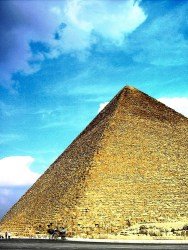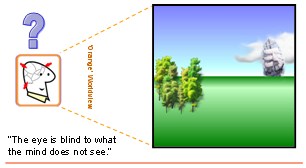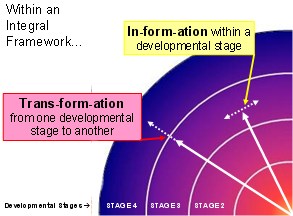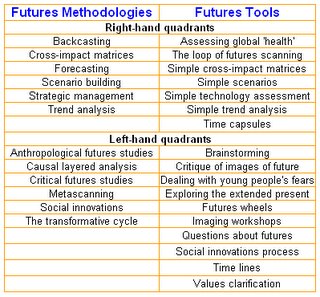Doing IT Differently - F: Conceptual Frameworks
What will be different at
HC in 2008?
F: Conceptual FrameworksThe shift in focus from information to
knowledge and understanding - and even wisdom - has emphasised the need to
highlight concepts, conceptual lenses and conceptual frameworks in curriculum design - as well as learning and teaching. (
eg see
Concept-Based Curriculum and Instruction by Erickson)
However, although
conceptual frameworks are used by educators in research and curriculum design they are not as often given to students to help them make their own connections.
Over the last few years a number of
colleagues have supplemented their teaching of the usual
topic or subject based concepts (
eg 'values', 'texture', 'evolution' or 'sustainability') with more
integrative frameworks such as
Senge's 'systems framework', Gardner's
'multiple intelligences framework' and
Wilber's 'four-quadrant framework'. The
response from students has been very positive.
 In 2008
In 2008 we plan to introduce integrative frameworks to computing students - particularly those doing interactive media involving Student Directed Inquiry (see
previous post). We will continue to use integrative
conceptual frameworks with students in English, Media and our academic achievement program.
Integrative conceptual frameworks help students to:
- move their thinking to the metacognitive level - thinking about thinking
- make sense of transdisciplinary inquiry - required in the Student Directed Inquiry course
- make connections to their existing knowledge and understanding
- know what they don't know - and know where to find out
- transfer learning to new situations - and cope with rapid change
- understand the importance of worldviews - and the need for collaborative inquiry
Exactly how we will use integrative conceptual concepts with computing students still needs to be worked out...
Previous - E: Assessment of, for and as Learning Next - F: Blended Learning
Labels: conceptual frameworks, integral, learning, metacognition, structure, teaching, transdisciplinary
Gone Slightly Mad?

From the expressions on their faces - they didn't say much so that's all I had to go on - my presentation left some students thinking that either I was slightly mad, mildly gullible or needed to go on extended holiday... Most however were in very deep thought... not quite sure what to make of it all... or me. And that's exactly what I intended.
I did a 15 min presentation of an enigma - although not everyone thought it was an enigma... but then that was partly my point :-)
The presentation is part of a series planned for 50 students who have opted for some extension work to help them with their academic program and today centred on the Great Pyramid at Giza.
Why the Great Pyramid? Most believed that we have a good understanding of Egyptian History - and we do. BUT there are some things that don't fit the generally accepted view - and one of them is the
Great Pyramid at Giza.
What's interesting is to see how different people react to this contradictory evidence. Some get quite emotional and become defensive or aggressively offensive. Others rationalise the whole thing away saying that it "doesn't really matter" or "who knows" or "you're probably wrong"... Others have a blind faith in the authority of recognised science, textbooks or experts. One student said: "If there was really a problem we would know about it."
Behind all of this is
Transformational Learning Theory and the idea that you can expand a person's worldview or perspective through the use of enigma or paradox. This is what I tried to do in this short presentation. There was no time for a rigorous look at the evidence just a peek through a small window into an alternate worldview.
A smaller group attended a follow-up lunch-time session and while the majority appear to look at the world through the eyes of
scientific empirical rationalism it was very clear that some had very different worldviews...
Students have the opportunity to continue the Great Pyramid discussion in an online forum. In a couple of weeks I intend to present some coherent theoretical frameworks based on
4 Quadrant Integral Theory to help students make sense of how worldviews (lower left quadrant) might affect inquiry in the remaining three.
But perhaps before I do that there is time to stir the pot and stretch my credibility a little more with some further enigma and paradox... :-)
Photo sourced from Flickr - Creative Commons LicenseLabels: engagement, learning, metacognition, transformation, worldviews
An Integral Part of Learning?
 More than 60% of year 11/12 teachers would consider using Integral Theory with their classes!
More than 60% of year 11/12 teachers would consider using Integral Theory with their classes!
Yesterday Sue (my wife) and I had the privilege of presenting aspects of Integral Theory to 50+ year 11/12 teachers in a non-government school. In spite of being a warm late afternoon and the fact that we covered 8 concepts and associated 'jargon' in 2 hours we received very enthusiastic responses.
I was surprised to discover quite a few teachers had already read some of Ken Wilber's work and a couple had already used aspects of Integral Theory with their classes.
This was the first time we've presented Integral Theory to a larger group of teachers - I presented the same concepts to several classes (yr 11/12) last year. From the mixed teacher feedback for some sections the balance of breadth to depth needs some adjustment - although I still think that a reasonable breadth is necessary to appreciate the coherence of the integral framework. There was less time for teacher discussion than with students who had a 3hr session.
More than half of those present said that they thought the concepts would be useful/very useful in their teaching. Many requested follow-up discussion so that they can develop the ideas for their classes. Some of this will be done through on-line presentations and forums over the next few weeks (although I've discovered the forum link has broken over the summer holidays).
In the last 10 minutes we touched briefly on 'stages of development' and 'information/transformation'. In retrospect this may have been a mistake in such a short time - although one teacher indicated that this was the most important part of the presentation for them.

Next week I'll begin working with some of the classes of teachers in government yr 11/12 colleges that were involved in last year's trials. We are going to introduce students to Integral Theory from the start of the year (classes start tomorrow in Tasmania) and develop the concepts as they progress through their courses.
Labels: conceptual frameworks, integral, metacognition, teaching
Integral Futures
 All education is futures education
All education is futures education according to Australian futurist
Richard Slaughter. He says most schools are about preparing students for active citizenship in the future. And
"young people do not need to be persuaded to consider the future. They already have powerful interests in the self-constitution of their own lives."
However he also says:
"The challenge is to re-invent schools on a new philosophical and operational basis, not see them over-whelmed by economic rationalism, still less by the over-hyped 'communications revolution'. "
I'm reading Futures Beyond Dystopia: Creating Social Foresight by Slaughter and think it has much to inform current curriculum initiatives - particularly now in Tasmania with Personal Futures and World Futures 'essential learnings' for K-10 and Futures a key purpose in the new Post-Year 10 Framework.
To avoid shallow and often overly Westernised and empirical futures perspectives Slaughter calls for an integral approach to futures at all levels of education including students, teachers, curriculum leaders and administrators. "The need is for a broader and deeper view of futures enquiry."
'Integral futures' is about including subjective inner realities along with objective outer realities - something often called for by holistic educators. Slaughter shows how Wilber's 4 Quadrant AQAL Integral Model provides a powerful conceptual framework that gives breadth, depth and balance to futures literacy, futures methodologies and futures tools.
In this way the critical importance of looking at cultural values, assumptions and worldviews (lower left quadrant) and the inner world of individual identity, meaning and purpose (upper left quadrant) as key aspects of any transformational process is not forgotten.
 Slaughter maps pop futurism, problem-oriented futures work, critical futures studies, epistemological futures, and environmental scanning across Wilber's quadrants showing the strengths and gaps in each approach over the last century.
Slaughter maps pop futurism, problem-oriented futures work, critical futures studies, epistemological futures, and environmental scanning across Wilber's quadrants showing the strengths and gaps in each approach over the last century.
Of course with all this talk of futures we need to remind ourselves that futures education is about empowering students in the present - or better still perhaps in the 'NOW' which includes and expanded sense of past-present-future.
I recently saw this Alan Watts Flash presentation on an Integral Education Forum which graphically shows the dangers of always looking to (waiting for) the 'future'... well worth a look if you haven't seen it.
With the current global focus on transforming learning and teaching an 'integral futures' perspective seems timely as we look at possible, probable and preferred educational futures - lest we forget the critical place of both individual and collective inner realities... for both students and teachers.
Labels: 21stCentury, conceptual frameworks, integral, metacognition, worldviews





 Slaughter maps pop futurism, problem-oriented futures work, critical futures studies, epistemological futures, and environmental scanning across Wilber's quadrants showing the strengths and gaps in each approach over the last century.
Slaughter maps pop futurism, problem-oriented futures work, critical futures studies, epistemological futures, and environmental scanning across Wilber's quadrants showing the strengths and gaps in each approach over the last century. 


